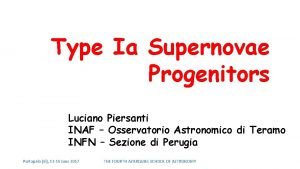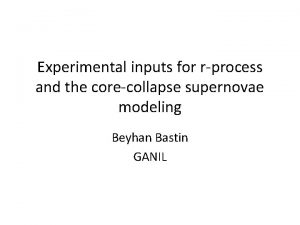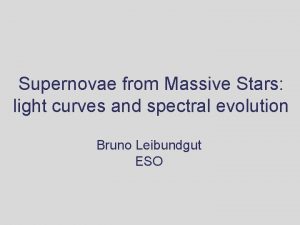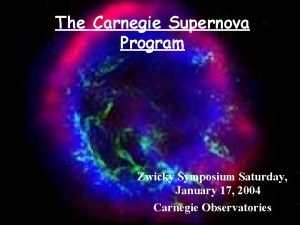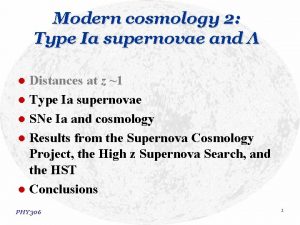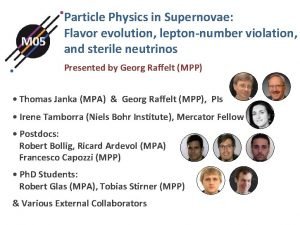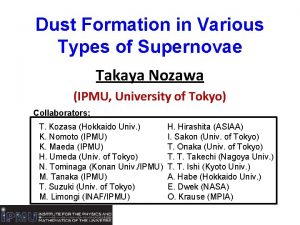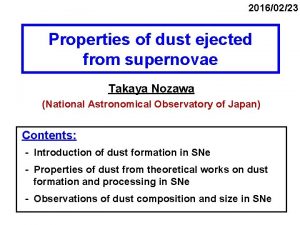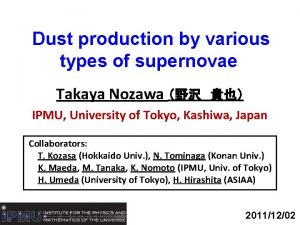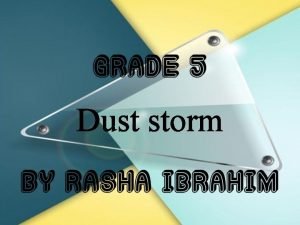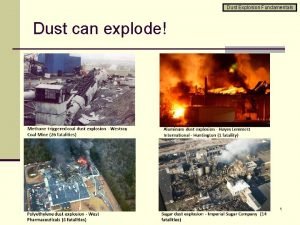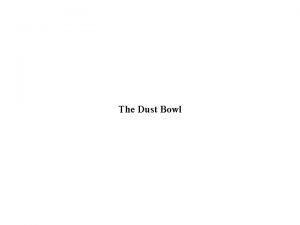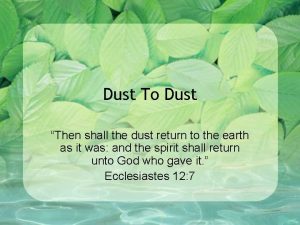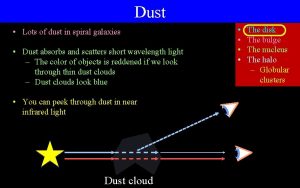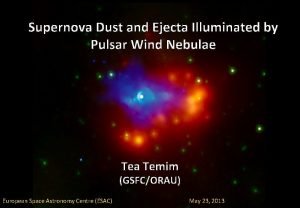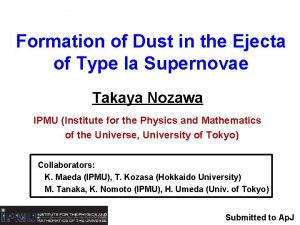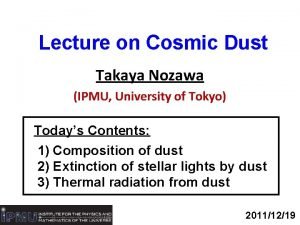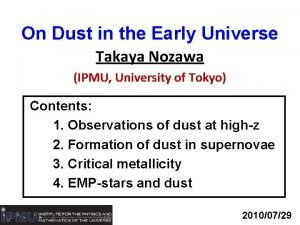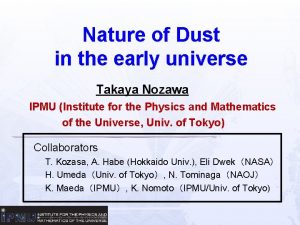20130530 Dust in the ejecta of supernovae Takaya


















- Slides: 18

2013/05/30 Dust in the ejecta of supernovae Takaya Nozawa Kavli IPMU (Kavli Institute for the Physics and Mathematics of the Universe) Collaborators: K. Maeda, K. Nomoto (Kavli IPMU) T. Kozasa, A. Habe (Hokkaido University) H. Umeda (U. T. ), N. Tominaga (Konan Univ. )

1 -1. Introduction 〇 SNe (and SNRs) are sources of - cosmic ray - kinetic and radiative energies - heavy elements - dust grains

1 -2. Sources of dust in our Galaxy Milky Way (optical) Milky Way (infrared) SNe are important sources of interstellar dust? - number (occurrence) ratio of SNe to AGB stars n(SNe) / n(AGB stars) ~ 0. 05 -0. 1 Mdust = 0. 1 -1. 0 Msun per SN (Nozawa et al. 2003; 2007) Mdust = 0. 01 -0. 05 Msun per AGB (Zhukovska & Gail 2008)

1 -3. Sources of dust in the early universe huge amounts of dust grains (>108 Msun) are detected in host galaxies of quasars at redshift z > 5 (< 1 Gyr) ➔ SNe arising from short-lived massive stars must be main producers of dust ➔ 0. 1 Msun of dust per SN is needed to be ejected to explain such massive dust at high-z (Dwek et al. 2007) theoretical studies predict that 0. 1 -1. 0 Msun of dust forms in SNe (e. g. , Nozawa et al. 2003) N/MIR observations of nearby SNe detect only < 10 -3 Msun (e. g. , Meikle et al. 2011) z=6. 4, at 350 μm

2 -1. Summary of observed dust mass in CCSNe SN 1987 A Crab theory missing cold dust? optically thick clumps? Cas A young SNRs swept-up IS dust? FIR to sub-mm observations have revealed the presence young SNe of massive (>0. 1 Msun) dust grains in the ejecta of CCSNe by courtesy of M. Tanaka What fraction of the newly formed grains can survive to be injected into the interstellar space?

2 -2. Emission and absorption efficiency of dust ○ Thermal radiation from a dust grain Fλ ∝ 4πa 2 Qemis(a, λ) πBλ(Tdust) # Qemis = Qabs carbon silicate (Qemis/a) is independent of a Fλ ∝ 4πa 3 (Qemis[a, λ]/a) πBλ(Tdust) ∝ 4 Mdust κemis(λ) πBλ(Tdust) ➔ IR emission is derived given Mdust, κabs, and Tdust

2 -3. Composition of dust formed in SNe IS dust : carbonaceous grain and silicate (Mg. Si. O 3, Mg. Fe. Si. O 4, …) SN 2004 et SN 2006 jc silicate ➔ 1750 K silicate carbon SN 2004 et, Kotak+09 carbon ➔ 1660 K SN 2006 jc, Smith+08

3. Formation and evolution of dust in supernovae He core FS RS CD

3 -1. Dust formed in Type II-P SNe average radius 0. 01 μm SN model: Umeda & Nomoto+02 Condensation time - various dust species form according to composition of gas in each layer - condensation time: 300 -600 d after explosion - average radii: >~0. 01 μm Nozawa+03, Ap. J, 598, 785

3 -2. Evolution of dust in SNRs Nozawa+07, Ap. J, 666, 955 Model : Type II-P Mpr= 20 Msun (E 51=1) n. H, 0 = 1 cm-3 Dust grains in the He core collide with reverse shock at (3 -13)x 103 yr The evolution of dust heavily depends on the initial radius and composition aini = 0. 01 μm (dotted lines) ➔ completely destroyed aini = 0. 1 μm (solid lines) ➔ trapped in the shell aini = 1 μm (dashed lines) ➔ injected into the ISM

3 -3. Mass and size of dust ejected from SN II-P Nozawa+2007, Ap. J, 666, 955 SNe II-P total dust mass surviving the destruction in Type II-P SNRs; 0. 07 -0. 8 Msun (n. H, 0 = 0. 1 -1 cm-3) size distribution of dust after RS destruction is domimated by large grains (> 0. 01 μm) at time of dust formation after destruction of dust by reverse shock

4 -1. Dust formation in Type IIb SN ○ SN IIb model (SN 1993 J-like model) - Meje = 2. 94 Msun MZAMS = 18 Msun MH-env = 0. 08 Msun - E 51 = 1 - M(56 Ni) = 0. 07 Msun

4 -2. Dependence of dust radii on SN type SN IIb SN II-P 0. 01 μm - the radius of dust formed in H-stripped SNe is small - condensation time of dust 300 -700 d after explosion ・ SN IIb without massive H-env ➔ adust < 0. 01 μm - total mass of dust formed ・ 0. 167 Msun in SN IIb ・ 0. 1 -1 Msun in SN II-P ・ SN II-P with massive H-env ➔ adust > 0. 01 μm Nozawa+10, Ap. J, 713, 356

4 -3. Evolution of dust in Type IIb SNR Time evolution of dust mass predicted IR SED at 330 yr Almost all newly formed grains are destroyed in shocked gas in the SNR Herschel observation due to small radius of Md, cool = 0. 075 Msun newly formed dust Tdust ~ 35 K (Barlow+10) Nozawa+10, Ap. J, 713, 356 ・ total mass of dust formed Mdust = 0. 167 Msun ・ shocked dust : 0. 095 Msun Md, warm = 0. 008 Msun ・ unshocked dust : Md, cool = 0. 072 Msun

5 -1. Scaling relation of average grain radius carbon silicate Λon: ratio of supersaturation timescale to gas collision timescale at the time of dust formation Λon = τsat/τcoll ∝ τcool ngas where τcool = ton / 3 (γ – 1) Nozawa & Kozasa in prep

5 -2. Dust formation in Type IIn SN 2010 jl carbon T = 1300 K Mg. Si. O 3 grains silicate T = 1450 K Dust in SN 2010 jl ・ carbon grains ・ grain radius: <0. 1μm (possibly <0. 01 µm) ・ dust mass: ~10 -3 Msun Maeda, TN, et al. 2013

5 -3. Average grain size in SNe 2010 jl and 1987 A carbon SN 2010 jl SN 1987 A SN 2010 jl ・ ton: 550 day ・ ngas < 109 cm-3 grain radius < 0. 08 µm Dust formation in cool dense shell SN 1987 A ・ grain radius: ~0. 01 -0. 05 μm (Kozasa et al. 1989; Todini & Ferrara 2001) ・ dust formation in clumps?

6. Summary of this talk 〇 There are increasing pieces of observational evidence that CCSN is a production factory of massive dust ➔ in good agreement with 0. 1 -1 Msun predicted by theory ➔ few observation to identify the composition and size of dust 〇 Size of newly formed dust depends on types of SNe - H-retaining SNe (Type II-P) : aave > 0. 01 μm - H-stripped SNe (Type IIb/Ib/Ic) : aave < 0. 01 μm ➔ H-stripped SNe are likely to be poor producers of dust 〇 We construct the universal relation to describe the average radius of newly formed dust grains ➔ being useful, given gas density and formation time of dust ➔ explaining grain size derived from observations of SN 2010 jl
 Supernovae
Supernovae Supernovae
Supernovae Supernovae
Supernovae Type ia supernovae
Type ia supernovae Supernovae
Supernovae Supernovae
Supernovae Các châu lục và đại dương trên thế giới
Các châu lục và đại dương trên thế giới Thế nào là hệ số cao nhất
Thế nào là hệ số cao nhất Slidetodoc
Slidetodoc Hệ hô hấp
Hệ hô hấp ưu thế lai là gì
ưu thế lai là gì Tư thế ngồi viết
Tư thế ngồi viết Cái miệng bé xinh thế chỉ nói điều hay thôi
Cái miệng bé xinh thế chỉ nói điều hay thôi Mật thư anh em như thể tay chân
Mật thư anh em như thể tay chân Chụp tư thế worms-breton
Chụp tư thế worms-breton Tư thế ngồi viết
Tư thế ngồi viết Thẻ vin
Thẻ vin Ví dụ về giọng cùng tên
Ví dụ về giọng cùng tên Thơ thất ngôn tứ tuyệt đường luật
Thơ thất ngôn tứ tuyệt đường luật
